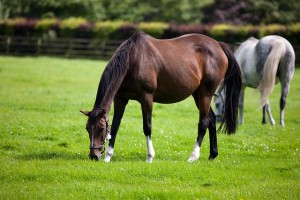The medieval horse.
Most people when they see those words tend to have something like this in mind.

A knight and his similarly armoured stallion.
But how often did the stallion end up in all his armour? And what did he do on his day off? Which sounds ridiculous, but is a valid point.
Most of the time he would have being doing this:
Or making foals…but you don’t need a picture of that…
Part of my research is looking for the evidence for the medieval horse studs – The word “stud” comes from the Old English ‘stod’ meaning “herd of horses, place where horses are kept for breeding” – within my study area of North Wales and North West Shropshire. There are several sources of evidence that I’ve been using and I thought I’d discuss them this week.
Firstly, there is the archaeological evidence – and this can be divided into the skeletal evidence for the horses themselves and the evidence for their horse ‘furniture’, pieces like reins, saddles and horseshoes. Skeletal evidence is, unfortunately, a bit thin on the ground, and where it does exist, for example at Aldford Castle in Cheshire (Longitude:53.130188; Latitude:-2.870270) it was very badly ‘smashed’ – that is to say, it was in pieces big enough to know it was a horse, but too small to be able to estimate the size of the horse.
I’ve previously discussed the loss of the site of Parc-y-Meirch (The Horse Park) in the blog post https://medievalparksgardensanddesignedlandscapes.wordpress.com/2013/07/08/archaeological-arrogance/ but fortunately during the rescue excavations medieval horseshoes were recovered from the site – which helped corroborate the second strand of evidence I want to discuss – the historical evidence.
Again, it is possible to divide the historical evidence into two sections, that is evidence for specific sites – such as the evidence from ‘The Survey of the Honour of Denbigh’ taken in 1334 which lists Parc-y-Meirch. The other section is the historical evidence which is non-site specific. An example of this can be found in the writings of Giraldus Cambrensis / Gerald of Wales:
“There are some excellent stud-farms. A superb race of blood-stock is now bred there, tracing its descent from the Spanish horses which Robert de Bellême, Earl of Shrewsbury, had gone to some pains to have imported long ago. The horses which are sent out from Powys are greatly prized: they are extremely handsome and nature reproduces in them the same majestic proportions and incomparable speed.”
Welsh poetry of the medieval period can also help understand the breeding programme. The poet Cynddelw Brydydd Mawr described Madog ap Maredudd (Prince of Powys from 1132-1160) as a ‘companion of Gascon horses’ and the poet Llywarch ap Llywelyn says that Llywelyn ap Iorwerth (Prince of Gwynedd 1195-1240) had Gascon horses. Gascony is in south west France (Longitude:43.763138; Latitude:-0.046619), so the importation of the horses appears to have gone on for at least a century.
Finally there is the pictorial evidence for horses in the Welsh Law Books – in Peniarth MS.28 on folio 24v there is a picture of a horse within the section of the law on horses:
So, as you can see from this small selection of sources, the study of horses and where they were kept and bred is full of variety and I’m really enjoying the research to find out more.


